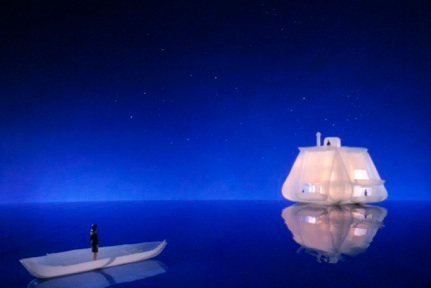Among contemporary American architects, John Johansen must surely be counted our most audacious and passionately dedicated Futurist—using that term not in its art-historical sense but rather to define an all-encompassing attitude toward life on planet earth, and perhaps ultimately beyond. During the past few decades, John and I saw each other only occasionally, most often at events in this building. I cannot recall a single such occasion when he did not gently but firmly urge me to disenthrall myself from confining attachments to the past and release myself from distracting preoccupations with the present, so that I could join him in the thrilling adventure of exploring the future. Well into his nineties, John was advocating the radical transformation of architecture with a refreshing mix of intelligence and daring that few architects can summon even in their twenties. Vivid evidence of his late-career experimental audacity can be seen the model of the project titled “Froth of Bubbles”, which is on display in the hall just outside this room [the American Academy of Arts & Letters].
John MacLane Johansen was born in New York City in 1916. Both of his parents, Jean MacLane and John Christen Johansen, were accomplished painters, and both, it should be noted, were later elected to membership in the National Institute of Arts and Letters, the parent body of this Academy. Their son John belonged to a generation of architects, including Edward Larrabee Barnes, Philip Johnson, I. M. Pei and Paul Rudolph, who were drawn in their youth to the Harvard Graduate School of Design by the charismatic presence and revolutionary teaching of Walter Gropius. All five of these Harvard-trained architects went on to establish practices that would define the late phase of modernism at mid-century and then contend in widely varied ways with its subsequent decline. In confronting the epistemological crisis that unsettled architecture in the nineteen sixties, Johansen’s always restless intellect, with its instinctive resistance to stylistic constraints, responded with a bold outburst of iconoclastic experimentation. It was my own enthusiasm for the resulting built works—most notably the Mummers Theater in Oklahoma City—that led to our initial meeting and lasting friendship.
My first visit to the Mummers Theater was indeed a transformative experience, beguiled as I was by the colorful cacophony of its playfully juxtaposed forms— forms that boldly flaunted the ambiguity, indeed the indeterminacy of their meaning and the values embodied therein. I certainly wanted to know the author of this audacious poke in the eye of convention and understand what made him tick.
The friendship thus initiated deepened when I accepted the chairmanship of architecture at Harvard in 1980. John then thoughtfully invited me to join him and Paul Rudolph at several working lunches in a rooftop pavilion of the First Avenue building where he had his office. On those occasions, John and Paul allowed me to burden them with some of the many doubts and questions that accompanied me as I stepped somewhat uncertainly into the academic world. The warmth of John’s generous hospitality and the stimulating impact of those wide-ranging conversations still glow in memory.










